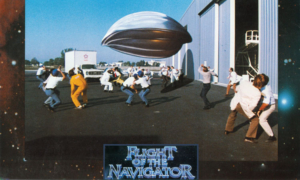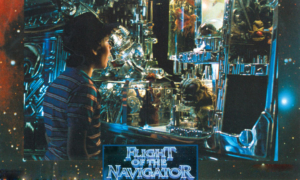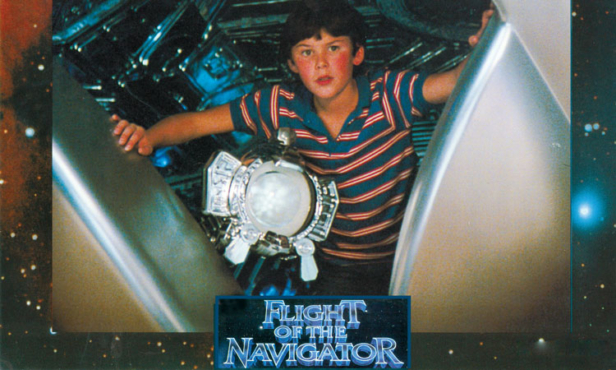“Did you see it when you were a kid?” asks Randal Kleiser as we settle into talking about his 1986 family SF cult classic Flight Of The Navigator. Having confirmed that we did indeed, and that we revisited it prior to this interview, the filmmaker chuckles and follows up with “…and did it look different?”
Going back to childhood favourites can be risky. For every classic that holds up, there’s a film that really tests the limits of your nostalgia. Thankfully, Flight Of The Navigator is very much the former, and it was recently reissued in a brand-new 4K restoration, supervised by Kleiser himself. It’s the story of a young boy named David (Joey Cramer), who wakes up after taking a tumble on 4 July 1978 to discover that it’s now 1986. As his parents race to find out where he’s been and why he hasn’t aged, NASA boffins realise that his reappearance is linked to the appearance of an alien spacecraft… Joey is the navigator, and the ship needs his help to get home.
How have you found the experience of going back and revisiting the film?
Oh, fun! It was nostalgic and I really had a good time making the movie down in Florida and then in Norway, which was a strange place, but yeah, the cast was wonderful.
We went back [to it] a few years ago and then the company came back and said they wanted to revamp it and show a lot of the behind the scenes stuff that’s never been seen before. Some of the tests that we did to get the look of the spaceship, the animals, the screen tests, things like that. So I went into the attic and pulled out a whole bunch of stuff, and the designs were really cool. We have a great interview with the artist who designed the spaceship, so the whole thing has come back to life for me and it’s fun.
What was it about the script that jumped out at you?
Well, it was a chance to do visual effects because I’ve always been a sci-fi fan. The reason I became a director was I saw the parting of the Red Sea in The Ten Commandments and I wanted to do visual effects. So the idea of being able to do a movie that had visual effects was exciting to me and I wanted to do something that had never been done before. My brother Jeff is a visual effects supervisor so he was experimenting with stuff in commercials and we got to adapt it to the movie.
There had been a lot of space movies done and they [were] all shot it the same way with models and motion control on the models. Star Wars and ET and Explorers and all these movies were done the same way, and I just wanted to find a new way to do a spaceship. So luckily my brother was able to come up with something that was different.

This was your first sci-fi feature. Was it a challenge jumping into this genre?
It was just something that was exciting that I’d always wanted to do so I wasn’t at all intimidated, I was just thrilled to try it. There were a couple of times that I was able to come up with shots that I’d thought up on the way to work that had not been done using mirrors. I just was having a blast being like a magician!
And what about the interior of the ship? It’s an iconic design, those shiny reflective surfaces…
I was just trying to think of something I hadn’t seen before and I came up with this idea of a reflective surface. Everyone said “don’t do that! You’ll be able to see the cameras…” I said: “Well, that’s probably why no one’s ever done it but let’s try it!” We did a lot of tests and we had to shoot a lot of takes to get it but I think it was worth it. It was tricky. But it worked, I think!
Disney came on board later on, at what point did you join Flight Of The Navigator? Was the script done?
I think it was pretty finished and we did some polishing to make it… There were two companies that made it, Producer Sales Organization and Disney. Producer Sales Organization was an action movie place, they wanted to have governments trying to shoot down the spaceship and chases and things like that and Disney wanted to concentrate on the family story, so guess who won!
It’s such a great cast, you mentioned that you saw them again recently…
Well, Joey’s been through a lot of stuff. We’re doing this documentary on him, Life After The Navigator, so the cast was very interested, they had not seen him since we shot the movie and they heard about all these things that he’s gone through. I think that’s one of the reasons why they came together so easily, they were curious to see him and hear about what happened and he’s now gotten his life together, he’s trying to get back into acting and everybody’s pulling for him. So that was great, the idea that everybody was coming together for him.
He’s so great in the film, such a naturalistic performance. How was it working with him?
He’s very easy to work with and I could tell from our original screen test (that we have on the extras of the DVD) where you can see him break into tears right away. And the moment I saw that I knew I could get anything out of him if he was able to do that right away in the audition. He cries several times in the movie and I never had to work with him, I just had to explain the situation and he could bring it to life. He’s still a very emotional guy, when we had the reunion for the documentary he actually teared up meeting his fellow cast members so I think he’s a very warm and humanistic kid. Well, he’s not a kid anymore, he’s 45!

What was the process of working with the Max puppet while shooting?
We had a wonderful puppeteer called Tony Urbano who I think used to work with Henson, and he was the voice of Max on the set and he also operated the puppet. So he would be up above on a cart that would roll around on the top of the set, and sticking down into the set was the puppet that he was operating with all these levers. So he would be up above saying the dialogue and Joey would be down below talking to the puppet, but it felt like it was a real character.
How did Paul Reubens come to play Max?
He was a friend of mine, I knew him from parties, from LA and all that, and I told him I was trying to find an unusual voice for the spaceship and we had done all sorts of tests with digital technology to change voices, using voice boxes and all that kind of stuff to get an unusual voice, and he volunteered to do it. He didn’t want any credit. He didn’t want his name on it. I guess he just is a quirky guy and didn’t want to have his real name so he used Paul Mall as his name. But everybody knew it was him, I mean, the moment he did his laugh you knew!
You mentioned that you had to shoot some of the film in Norway…
Yeah, well, it was very unusual to shoot interiors in Norway! It’s because of some block funds that have to be spent there so we built the set in America and then ripped it down and took it in boxes to a warehouse an hour outside of Oslo and put it together and then we had to drive an hour through the freezing cold in February to get to the unheated warehouse and shoot it. So it was not pleasant but it was certainly memorable and interesting.
When did you start to realise that it was becoming a classic?
You know, when it first came out it was kind of lost in the shuffle. I think there were some other big movies that came out then, but over the years that’s when I’ve noticed people coming up to me and saying: “Oh, I love that film, I’ve seen it a million times.” Because of VHS and DVD and streaming, these movies don’t die. People can still see them which is great. They can have a life of their own and rise to cult status and have a much bigger following than they ever did when it first came out.
You have worked in a lot of different genres but is there anything that you haven’t really tried yet that you would like to?
Yeah, it’s fun to do different things. I wouldn’t want to keep repeating the same kind of movie over and over again and that’s why I think it would be difficult for me to do a series that went on and on for years. But I love the idea of trying different things and having the opportunity to experiment. Right now I’ve just finished a 12-part virtual reality series that’s designed to be watched on a headset. That was a whole different way of shooting and I love sci-fi, so this is a sci-fi movie and I used a lot of sci-fi actors, so trying different things has always been something I love.
How do you feel about the proliferation of different ways to watch movies now?
I think that virtual reality is really the next step in filmmaking. The best way to see a movie is in a big theatre with an audience. The second best way to look at a movie is in virtual reality. Not a movie but a virtual reality project that’s shot for that because it’s bigger than a movie. You’re in it, you’re surrounded by it and it feels like you’re a part of it. It’s bigger than IMAX, you know? So those are the two areas that I like. A big movie theatre or virtual reality experience.
Flight Of The Navigator Limited Edition is available on Blu-ray now.
